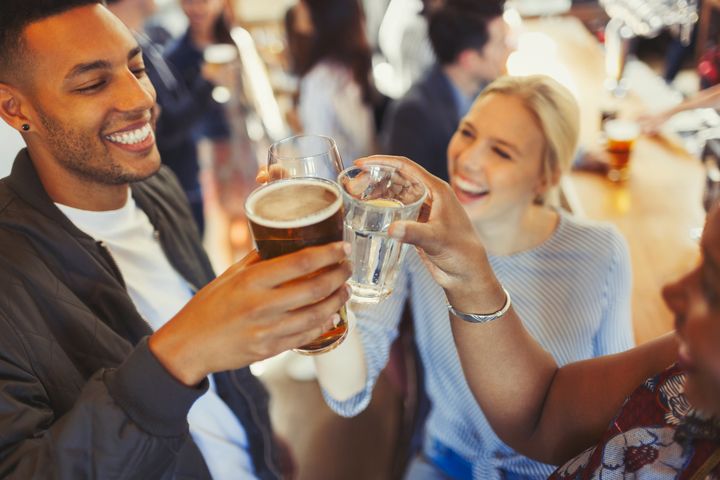How To Make Drinking Just A Tiny Bit Better For You
A delicious cocktail or a cold beer pairs well with this time of year. But it’s also no secret at this point that your drink can also be wildly unhealthy.
Alcohol can dehydrate you, increase your daily sugar intake and more. Research has also found that alcohol consumption may be linked to an increased risk of cancer, sleep disruption and weight gain.
As with anything, moderation is key (as long as drinking isn’t completely affecting your daily life, of course, in which case it’s vital to quit altogether and possibly seek treatment). If you are able to drink socially, there are certain steps that you can take in order to make alcohol a little easier on your body.
HuffPost chatted with some experts on how to ease back on the booze and make it just a little bit better for you when you do imbibe during a holiday or an evening with friends. Take a look at their recommendations below:
Opt For Lower ABVs
Pay attention to a beverage’s ABV, or alcohol by volume. The typical ABV of a craft beer, for instance, is 5.9%. However, something like the 120 Minute IPA by Dogfish Brewery contains a whopping 15 to 20% ABV. So if you’re looking to be kinder to your liver, it might be wise to opt for a beer that doesn’t hit the double-digit ABV mark.
This also applies to wine. “Many European wines from cooler climates, like a pinot noir from Burgundy, provide a lower sugar and lower alcohol without compromising flavor,” said Barney Treadway, founder of the Wine Education Institute and co-owner of the Bitto Bistro in Westminster, CO.
Be Mindful Of Portions

Everyone appreciates a good pour but it might not be doing your body any favors. “Portions are key. One drink technically equals 5 fluid ounces of wine, 12 fluid ounces of beer or 1.5 fluid ounces of a spirit like vodka, gin or tequila,” said Dana Angelo White, a nutrition consultant, registered dietitian and certified athletic trainer in Fairfield, Connecticut.
That can add up quickly: Many glasses of wine, beer or mixed drinks contain multiple servings of alcohol, White noted. Basically, it’s important to keep in mind that one pour doesn’t necessarily equate to one serving. Thus, drinking a pint of beer (around 16 ounces) is larger than a recommended serving and is more than the liver can process in an hour.
Make Your Own Syrups
Store-bought syrups for cocktails are convenient but can be packed with unhealthy sweeteners and excessive grams of sugar. Sam Nelis, beverage director of Caledonia Spirits, suggested whipping up your own healthier versions.
“This way you can be sure that you are using a decent source of real sugar, and know the exact amount that is in syrup,” he said. Nelis recommended swapping sugar for more natural sweeteners like raw honey, maple or agave syrup, or using ingredients like fresh berries, “which you can muddle to add sweetness to a drink without adding extra sugar.”
Choose The Real Stuff
“You read the back of every food label you potentially eat, but do you ever look up the brands you drink?” said Pamela Wiznitzer, a mixologist at The Lookup, a rooftop bar in New York.
If your liquors are filled with artificial flavors that you can’t pronounce, Wiznitzer suggested making your own. She noted that you can craft your own fireball whiskey, for example, by “infusing some bourbon with a cinnamon stick and a few sugar cubes.”
Nelis added that if you use quality spirits, you don’t need to add a heavy dose of other caloric and sugary ingredients to your mixed drinks in order to “mask the flavor,” either.
Fuel Up With Food
Aim to have a balanced meal close to the time you’ll be consuming alcohol, said Wendy Lopez, a registered dietitian in Port Chester, New York, and the in-house dietitian for Vita Coco.
“Drinking alcohol on an empty stomach can irritate your digestive system. It can also result in faster absorption of alcohol,” Lopez said.
Michelle Miller, a clinical nutritionist at Physio Logic in New York, said that ideally you want to consume a combination of high-quality protein, healthy fats and complex carbohydrates. “This will help to control the rise of alcohol in the blood, as alcohol is first absorbed through the lining of the GI tract. High-fiber foods can help to slow the release of alcohol in a similar way,” she said.
Hydrate

Alcohol is a diuretic and can actually dehydrate you while you consume it, according to Thanu Jey, the clinic director at Yorkville Sports Medicine Clinic in Toronto. “Furthermore, alcohol flushes important electrolytes out of your system if you don’t properly hydrate. This also makes for a worse hangover,” he said.
The solution? “Drink a glass of water between every glass of alcohol,” recommended Mike Clancy, a personal trainer in New York. He said that this simple 1:1 ratio principle can significantly improve your next-day outcome.
Ditch The Soda
Everyone loves a good rum and coke, but a can may set you back 140 calories and give your drink an added 39 grams of sugar.
Ariane Resnick, a private chef, certified nutritionist and author of “The Thinking Girl’s Guide to Drinking,” suggested avoiding soda as a mixer because that excess sugar can increase your potential for hangovers. Fruit juice can do the same (for example, one cup of generic orange juice can pack in 21 grams of sugar). Stick with seltzer.
Don’t Overdo It
It seems obvious, but know your limit. Try figuring out how much you want to drink during an outing and then refrain from going over that amount, explained Ashley Wood, a registered nurse in Lawrenceville, Georgia.
“If you know that you’re going to be drinking, make sure to plan ahead by deciding how much you’re going to have and then stick to it. This can be challenging, especially if people you’re with are drinking heavily and are encouraging you to do the same,” but you’ll thank yourself later, Wood said.
This doesn’t imply that you should pick a high number of drinks for the night. Keep in mind the recommended limits: Binge drinking is considered as five or more drinks on a single occasion for men or four or more drinks on a single occasion for women, according to the Centers for Disease Control and Prevention.
Have An Early “Last Call”

Drinking too close to bed may seem like it’ll lure you into a good sleep, but it actually does the opposite and messes with your sleep cycle, Wood said.
“The average person metabolizes alcohol at a rate of around 0.01% to 0.02% per hour. So, if you fell asleep with a blood alcohol level of 0.06 to 0.08, the alcohol would be out of your system after about four or five hours,” she said. This is usually in the middle of the night or early morning, depending on what time you went to bed. Cue the poor sleep.
The best way to prevent this from happening is to stop drinking ideally at least four hours before you go to sleep, Wood said. And, of course, drink lots of water after that.
Need help with substance abuse or mental health issues? In the U.S., call 800-662-HELP (4357) for the SAMHSA National Helpline.

Source: Read Full Article
